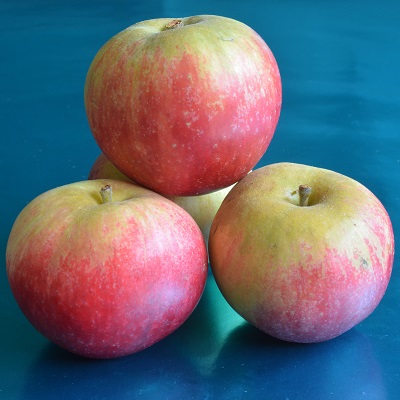Gala apples are bi-coloured with an attractive orange-red blush, which is most commonly striped and exposes a white-yellow background colouration. The fruit has sweet, yellowish flesh and an attractive crisp texture, but with no particular stand-out flavour characteristics.
Gala is very popular because of it’s attractive appearance as well as its sweetness and texture, and is ready availability throughout the year. The fruit is prone to softness with over-maturity, so harvest timing and effectiveness of storage is paramount. Gala is available in stores all year round, and with the advent of SmartFresh, its condition can be maintained for significantly longer than under conventional ULO storage. There may be some lost flavour with long storage, but only marginally, though freshly harvested fruit have a more attractive aroma.
A different eating quality is evident in Gala from various source countries, whether through clones or growing conditions. Those from Brazil develop a unique flavour, perhaps the best of all origins, but sadly have a reputation for variable texture. The New Zealand-grown fruit, the ‘original’, is the classic Gala in all respects. Gala from England is also quite distinctive, with good colouration, texture and sweetness.
‘Royal Gala‘ is a Gala with more than 50% red colouration of the skin: they taste the same!
Quality: Avoid fruit with a yellow rather than white/yellow background colour.
Good Fruit Guide Rating: ***
At its best, Gala is a lovely variety, attractive in appearance and reliably sweet and crisp.
Crisp, sweet, reliable.
Origin: Gala originates in New Zealand and is a cross between Kidd’s Orange Red and Golden Delicious.
Grown in: All apple-producing countries.
Harvest & Availability: Northern hemisphere Gala are harvested between late August and late September; southern hemisphere Gala is harvested between early February (Brazil) and early March (New Zealand).
- January: UK and Europe
- February: UK and Europe
- March: UK and Europe
- April: South Africa, Argentina, Chile, New Zealand, Brazil, UK
- May: South Africa, Argentina, Chile, New Zealand, Brazil, UK
- June: South Africa, Argentina, Chile, New Zealand, Brazil, UK
- July: South Africa, Argentina, Chile, New Zealand, Brazil
- August: South Africa, Argentina, Chile, New Zealand, Brazil
- September: South Africa, New Zealand, UK and Europe
- October: UK and Europe
- November: UK and Europe
- December: UK and Europe





David Barneby –
Gala and Royal Gala are not the same , in the absence of Cox’s Orange Pippin or Braeburn I would choose Gala . I understand that Royal Gala is hybrid with Red Delicious thus becoming slightly more elongated and beautiful red colour . New Zealand Gala are sweeter with softer skin , I find Royal Gala almost tasteless and has a tough leathery skin like the American Red Delicious .
Nick Ball –
David,
Thanks for your comment.
Royal Gala is actually a natural sport of Gala, which is itself the result of a cross between Kidd’s Orange Pippin and Golden Delicious: there is no involvement from Red Delicious. A natural sport of a variety occurs in the orchard through natural mutations which are subsequently selected by growers if they exhibit different characteristics. Gala is very interesting in this respect as it has been taken all over the apple-growing world and numerous selections, mostly for colour, have been identified in various places. The name Royal Gala was originally used early in the life of the variety to distinguish it as a Gala with a higher percentage of red colouration (encouraged by supermarkets), so it wasn’t a sport as such. Since then, there have been many different selections with names such as Tenroy or Mondial, but these names can cause confusion for consumers so are rarely used by retailers.
Also interesting about Gala, as you mention, are the variations in shape, flavour, and peel and flesh texture. These are the result of the differing growing conditions of the variety across the world which convey variations of the original New Zealand version, some of which can be quite marked. I always find it fascinating, for example, that the Brazilian Gala has a distinctive flavour that is not replicated from anywhere else.
A good explanation of the variety can be found here: http://www.orangepippin.com
Regards,
Nick Ball